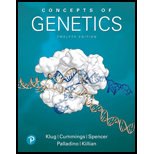
Concepts of Genetics Plus Mastering Genetics with Pearson eText -- Access Card Package (12th Edition) (What's New in Genetics)
12th Edition
ISBN: 9780134811390
Author: William S. Klug, Michael R. Cummings, Charlotte A. Spencer, Michael A. Palladino, Darrell Killian
Publisher: PEARSON
expand_more
expand_more
format_list_bulleted
Concept explainers
Textbook Question
Chapter 14, Problem 4PDQ
Francis Crick proposed the “adaptor hypothesis” for the function of tRNA. Why did he choose that description?
Expert Solution & Answer
Want to see the full answer?
Check out a sample textbook solution
Students have asked these similar questions
The following table is from Kumar et. al. Highly Selective Dopamine D3 Receptor (DR) Antagonists and Partial Agonists Based on Eticlopride and the D3R Crystal Structure: New Leads for Opioid Dependence Treatment. J. Med Chem 2016.
The following figure is from Caterina et al. The capsaicin receptor: a heat activated ion channel in the
pain pathway. Nature, 1997. Black boxes indicate capsaicin, white circles indicate resinferatoxin.
You are a chef in a fancy new science-themed restaurant. You have a recipe that calls for 1 teaspoon of resinferatoxin, but you feel uncomfortable serving foods with "toxins" in them. How much capsaicin could you substitute instead?
What protein is necessary for packaging acetylcholine into synaptic vesicles?
Chapter 14 Solutions
Concepts of Genetics Plus Mastering Genetics with Pearson eText -- Access Card Package (12th Edition) (What's New in Genetics)
Ch. 14 - Prob. 1NSTCh. 14 - A series of mutations in the bacterium Salmonella...Ch. 14 - HbS results from the substitution of valine for...Ch. 14 - Given that a faulty ribosomal protein is the...Ch. 14 - A couple with a child affected with DBA undergoes...Ch. 14 - Prob. 3CSCh. 14 - HOW DO WE KNOW? In this chapter, we focused on the...Ch. 14 - CONCEPT QUESTION Review the Chapter Concepts list...Ch. 14 - Contrast the roles of tRNA and mRNA during...Ch. 14 - Francis Crick proposed the adaptor hypothesis for...
Ch. 14 - During translation, what molecule bears the codon?...Ch. 14 - The chain of eukaryotic hemoglobin is composed of...Ch. 14 - Assuming that each nucleotide in an mRNA is 0.34...Ch. 14 - Summarize the steps involved in charging tRNAs...Ch. 14 - To carry out its role, each transfer RNA requires...Ch. 14 - What are isoaccepting tRNAs? Assuming that there...Ch. 14 - When a codon in an mRNA with the sequence 5-UAA-3...Ch. 14 - Discuss the potential difficulties of designing a...Ch. 14 - Prob. 13PDQCh. 14 - Prob. 14PDQCh. 14 - The synthesis of flower pigments is known to be...Ch. 14 - The study of biochemical mutants in organisms such...Ch. 14 - Explain why the one-gene: one-enzyme concept is...Ch. 14 - Why is an alteration of electrophoretic mobility...Ch. 14 - Prob. 19PDQCh. 14 - Prob. 20PDQCh. 14 - Prob. 21PDQCh. 14 - Prob. 22PDQCh. 14 - Several amino acid substitutions in the and ...Ch. 14 - Define and compare the four levels of protein...Ch. 14 - What are the two common types of protein secondary...Ch. 14 - How do covalent disulfide bonds, hydrogen bonds...Ch. 14 - Prob. 27PDQCh. 14 - List three different types of posttranslational...Ch. 14 - Prob. 29PDQCh. 14 - How does an enzyme function? Why are enzymes...Ch. 14 - Prob. 31PDQCh. 14 - Three independently assorting genes (A, B, and C)...Ch. 14 - How would the results vary in cross (a) of Problem...Ch. 14 - Deep in a previously unexplored South American...Ch. 14 - Many antibiotics are effective as drugs to fight...Ch. 14 - The flow of genetic information from DNA to...Ch. 14 - Prob. 37ESP
Knowledge Booster
Learn more about
Need a deep-dive on the concept behind this application? Look no further. Learn more about this topic, biology and related others by exploring similar questions and additional content below.Similar questions
- 1. Match each vocabulary term to its best descriptor A. affinity B. efficacy C. inert D. mimic E. how drugs move through body F. how drugs bind Kd Bmax Agonist Antagonist Pharmacokinetics Pharmacodynamicsarrow_forward50 mg dose of a drug is given orally to a patient. The bioavailability of the drug is 0.2. What is the volume of distribution of the drug if the plasma concentration is 1 mg/L? Be sure to provide units.arrow_forwardDetermine Kd and Bmax from the following Scatchard plot. Make sure to include units.arrow_forward
- Choose a catecholamine neurotransmitter and describe/draw the components of the synapse important for its signaling including synthesis, packaging into vesicles, receptors, transporters/degradative enzymes. Describe 2 drugs that can act on this system.arrow_forwardThe following figure is from Caterina et al. The capsaicin receptor: a heat activated ion channel in the pain pathway. Nature, 1997. Black boxes indicate capsaicin, white circles indicate resinferatoxin. a) Which has a higher potency? b) Which is has a higher efficacy? c) What is the approximate Kd of capsaicin in uM? (you can round to the nearest power of 10)arrow_forwardWhat is the rate-limiting-step for serotonin synthesis?arrow_forward
arrow_back_ios
SEE MORE QUESTIONS
arrow_forward_ios
Recommended textbooks for you
 Human Heredity: Principles and Issues (MindTap Co...BiologyISBN:9781305251052Author:Michael CummingsPublisher:Cengage Learning
Human Heredity: Principles and Issues (MindTap Co...BiologyISBN:9781305251052Author:Michael CummingsPublisher:Cengage Learning BiochemistryBiochemistryISBN:9781305577206Author:Reginald H. Garrett, Charles M. GrishamPublisher:Cengage Learning
BiochemistryBiochemistryISBN:9781305577206Author:Reginald H. Garrett, Charles M. GrishamPublisher:Cengage Learning Biology Today and Tomorrow without Physiology (Mi...BiologyISBN:9781305117396Author:Cecie Starr, Christine Evers, Lisa StarrPublisher:Cengage Learning
Biology Today and Tomorrow without Physiology (Mi...BiologyISBN:9781305117396Author:Cecie Starr, Christine Evers, Lisa StarrPublisher:Cengage Learning Biology (MindTap Course List)BiologyISBN:9781337392938Author:Eldra Solomon, Charles Martin, Diana W. Martin, Linda R. BergPublisher:Cengage Learning
Biology (MindTap Course List)BiologyISBN:9781337392938Author:Eldra Solomon, Charles Martin, Diana W. Martin, Linda R. BergPublisher:Cengage Learning Biology 2eBiologyISBN:9781947172517Author:Matthew Douglas, Jung Choi, Mary Ann ClarkPublisher:OpenStax
Biology 2eBiologyISBN:9781947172517Author:Matthew Douglas, Jung Choi, Mary Ann ClarkPublisher:OpenStax

Human Heredity: Principles and Issues (MindTap Co...
Biology
ISBN:9781305251052
Author:Michael Cummings
Publisher:Cengage Learning

Biochemistry
Biochemistry
ISBN:9781305577206
Author:Reginald H. Garrett, Charles M. Grisham
Publisher:Cengage Learning

Biology Today and Tomorrow without Physiology (Mi...
Biology
ISBN:9781305117396
Author:Cecie Starr, Christine Evers, Lisa Starr
Publisher:Cengage Learning

Biology (MindTap Course List)
Biology
ISBN:9781337392938
Author:Eldra Solomon, Charles Martin, Diana W. Martin, Linda R. Berg
Publisher:Cengage Learning

Biology 2e
Biology
ISBN:9781947172517
Author:Matthew Douglas, Jung Choi, Mary Ann Clark
Publisher:OpenStax

Mitochondrial mutations; Author: Useful Genetics;https://www.youtube.com/watch?v=GvgXe-3RJeU;License: CC-BY